Late summer lets Fiat 124 Spider roll
By John Gilbert
When summer lingers into fall, and summer-like days reach into November, it’s the time fond memories are rekindled. Similarly, whenever the term “sports car” is mentioned in my presence, I slip into an instant reverie about a curvy roadway on an autumn afternoon, sunshine everywhere and colored leaves scattered all around.
Into that pastoral scene comes a two-seat roadster, top down, engine smoothly sounding out its powerful potential while being kept within the restraints of a light right foot. As the roadster approaches, it carves the curvature of the roadway perfectly, and as it passes, it leaves a swirling wake of blowing leaves.
Now THAT’S what a true sports car should be. It’s always been that way in my mind, and this autumn of 2016 is the perfect scenario, because in the Northland, instead of Gales of November, we’re all pretty astonished that we’re watching thermometers rise into the 60s.
If it’s a perfect scenario for a roadster, there also are a couple of roadsters that perfectly fit the scene as well. We all know and love the Mazda MX-5 Miata, the most enduring affordable sports car on the planet. And the newly redesigned Miata now has a sibling, in disguise this time around — the Fiat 124 Spider.
Back when Fiat used to send cars to the U.S. in the 1960s, one of the most popular was the Fiat 124, both in coupe and roadster form. The coupe was a 2-plus-2 with an actual rear seat. The roadster, however, was the Spider — a true sports car, with a soft top that could be stowed behind the two bucket seats, and a willing and great-sounding 4-cylinder engine.
Fiat is making its return to the U.S., with its little compact 500 sedan, and all its derivatives, and now, for 2017, the return of the 124 Spider. To create the new Spider, Fiat worked out a deal with Mazda for the new MX-5 Miata platform. But it wasn’t content to just rebadge the Miata and use its splendid Skyactive 4-cylinder engine. Instead, Fiat pulled out its own 1.4-liter 4-cylinder from the Fiat 500 Abarth pocket-rocket, and fitted it into the new 124.
As good as the Miata is at performing and handling when you throw it into a turn or whirl around a cloverleaf with perfect precision, the Fiat 124 Spider rivals that. Fiat added 5 inches of length to stretch the 124 out into an elongated shape that becomes distinctive when you park it next to a Miata.
If the car lost a little bit of its sportiness in the transition, it also gained a dash of elegance. It has a distinct look to its grille, reminiscent of the Fiat 124 Spider from generations past.
It is thoroughly modern in its demeanor otherwise, particularly with the glassed-in headlights and smooth side view, which differentiates from the Mazda with a character line that rises from mid-door toward the rear. Hard to quarrel with those Italians when it comes to style and the passion they spend to display that style.
Fiat, of course, is the parent company for Ferrari, and Alfa Romeo, and does just fine on its own, thank you. So when it removed the Skyactive Mazda engine from the platform, it didn’t shirk its responsibility for sportiness by fitting the 1.4-liter MultiAir engine, turbocharging it, and giving it either a 6-speed stick or a 6-speed automatic transmission.
The MultiAir is a technique that is truly unique — much like Skyactive but in a whole ’nother way. With an engine, an overhead camshaft is more efficient than pushrods, and dual overhead cams — one for intake and one for exhaust valves — are doubly more efficient. But with MultiAir, Fiat engineers have gone to a once-used Formula 1 scheme, replacing the intake camshaft with a system of oil-filled tubes that are attached to the exhaust camshaft.
So every time the exhaust cam spins, actuating the exhaust valves, it also sends the little oil-filled tubes pumping to actuate the intake valves across the way. The advantage is that in this modern era of engine operation by computer programs, being able to advance or inhibit the valve overlap by keeping the valves open longer is important, and MultiAir allows almost infinite valve adjustment.
Fiat engineers have told me that the system could be used to replace both camshafts, but it is expensive, and keeping one cam makes efficient sense.
At only 1.4 liters, the engine doesn’t seem all that imposing, but turbocharging it can extract 160 horsepower and 184 foot-pounds of torque, which is more than sufficient to let you fling the 124 Spider on its appointed vectors. Especially with the 6-speed stick, the way the test car was equipped.
Naturally, one of the main reasons my roadster reverie revolves around a beautiful Native American Summer afternoon, with the leaves being blown about by the car’s wake and the temperature high enough for the top to be down, is because such roadsters aren’t generally usable from November through March in places like Minnesota.
With front engine and rear drive, and the intent to send bursts of power to the rear drive wheels on command, negotiating wintry roads and icy hills is not exactly a strong suit. We have SUVs of all sizes and all-wheel-drive vehicles to cope with that sort of thing.
But when it’s warm, and dry, there are few things in motoring that can approach the exhilaration of top-down driving in a perfect-handling roadster. From a practicality side, there is the base price. For the Fiat 124 Spider, prices start at $25,000, which is reasonable indeed for the fun being engineered into each car.
Also, the lightweight, but strong, 124 Spider showed an easy 36.2 miles per gallon while cruising at freeway trip speeds of 75 or so mph.
There are a few unwritten rules about roadster/convertible driving in my world. You can drive the car with the top up and windows tightly closed, and it will be warm and cozy in very cold weather. But you want the car to excel when conditions are warm, or at least passably cool.
At those times, you can leave the top up and the windows up. But if you’re going to put the top down, then please also lower the side windows. It looks jarring to see a sleek roadster with the top down and the side windows up! If you must put them up to avoid hypothermia, OK, but it’s preferable to first try to dress warmer, use the heater and even seat-heaters if you’ve got them. You also can wear a wool cap, or a parka, and with fleece and down these days, you can shield yourself from moderate cold — and still not look too wimp-like.
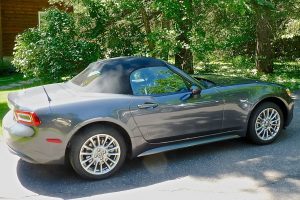
The top goes up or down with a one-handed flick of the wrist in case foul weather intrudes on your idyllic drive.
In normal roadster weather, you will enjoy the ease with which the soft top goes up and down on the Fiat 124 Spider. Grasp and turn the center-located top latch, push up and the front of the top rises, just enough so you can push it back easily and it drops into the receptacle behind the seats. The top stashes all in one motion, and locks in place with a hard cover keeping it there.
To raise it, hit the release and it pops up just a bit so you can grasp it and pull it forward, where it easily fits and you can lock it in place. You could do it, one-handed, while driving along at under 30 mph, it’s that simple.
The bucket seats are comfortable and enveloping, and there is a large stowage cubicle between and behind the seats, which offsets the tiny console bin between the seats.
The Fiat 124 Spider is properly at its best when being driven, and you can drive it as hard as you’d like. In a Corvette, or other powerful sports car, you can have a lot of fun, but you have to be going fast to enjoy it. With a car like the Fiat 124 Spider, you can have incredible thrills at 30 mph on a cloverleaf, as the car traces a perfect arc as if it is on rails.
You feel as though you could fling it through turns far faster, because of the near-flawless handling attitude it displays at every turn, and the crackling roar of the turbocharged engine adds to the sensory overload you experience every time you climb in.
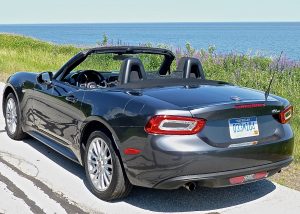
From grille to rear, the 124 Spider is 5 inches longer and bears no resemblance to the Mazda MX-5 Miata.
The test car I drove along North Shore Drive as often as possible for a week did not have satellite radio, or a CD player. It did have a plug-in outlet for an iPod or MP3 player, if you insist on letting real-world sounds intrude on your idyllic fantasy-world of roadster driving.
Me? I love radio/satellite/CD music when I’m driving in a normal car, truck or SUV. But as a preference, I’ll take the impatiently crackling engine sound over any audio system, with the top-down, and dried leaves blowing up behind me as I revisit Hwy. 61 on the North Shore on a sunny day in the 60s.
That way, I don’t have to spend any of those familiar reveries, and can preserve them for those long weeks of winter, when the 124 Spider is securely tucked away in my garage. Oops! Now I’ve got a reverie that I own the car.


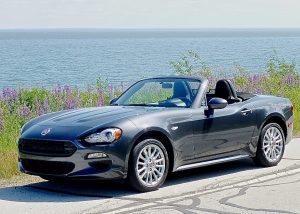
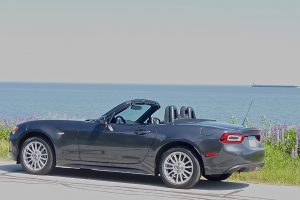
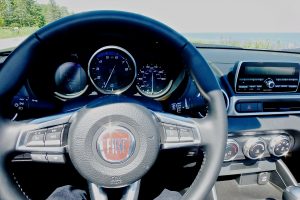
 John Gilbert is a lifetime Minnesotan and career journalist, specializing in cars and sports during and since spending 30 years at the Minneapolis Tribune, now the Star Tribune. More recently, he has continued translating the high-tech world of autos and sharing his passionate insights as a freelance writer/photographer/broadcaster. A member of the prestigious North American Car and Truck of the Year jury since 1993. John can be heard Monday-Friday from 9-11am on 610 KDAL(www.kdal610.com) on the "John Gilbert Show," and writes a column in the Duluth Reader.
John Gilbert is a lifetime Minnesotan and career journalist, specializing in cars and sports during and since spending 30 years at the Minneapolis Tribune, now the Star Tribune. More recently, he has continued translating the high-tech world of autos and sharing his passionate insights as a freelance writer/photographer/broadcaster. A member of the prestigious North American Car and Truck of the Year jury since 1993. John can be heard Monday-Friday from 9-11am on 610 KDAL(www.kdal610.com) on the "John Gilbert Show," and writes a column in the Duluth Reader.